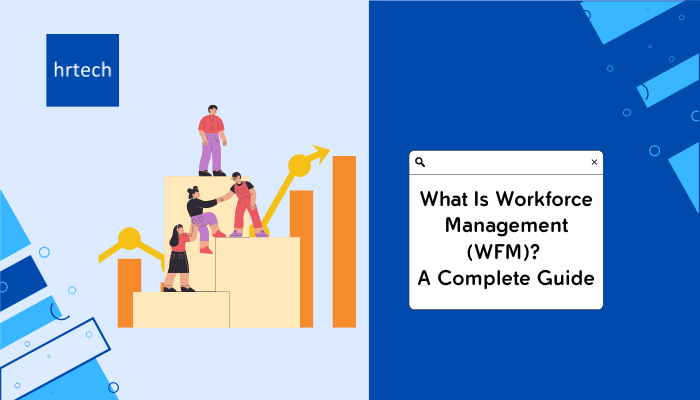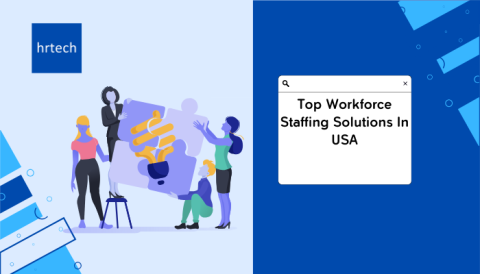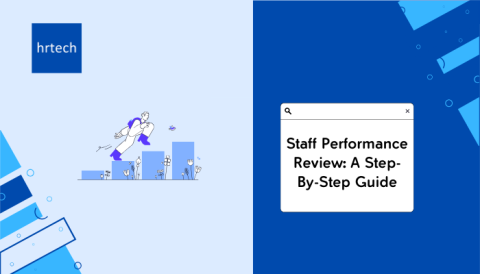Managing a team effectively can be a challenge, especially as your business grows. That’s where Workforce Management (WFM) comes in.
But what exactly is Workforce Management, and why is it so important?
In this guide, we’ll break down everything you need to know about WFM, right from the fundamentals. You’ll learn what WFM is, how it works, its key components, its benefits, types, challenges, solutions, and more.
Ready? Let’s dive right in!
What Is Workforce Management?
Workforce management is all about making sure your team works efficiently.
It’s the process of handling your employees’ work, including scheduling, tracking time, and managing absences.
It’s not the same as human resources (HR) management, though. HR focuses more on hiring, training, and supporting employees. Workforce management is specifically about optimizing day-to-day work.
For example, let’s say you run a restaurant. Workforce management would involve creating schedules so you have enough servers and cooks during busy times.
You’d also track when employees clock in and out, and manage time off requests to avoid being short-staffed.
So, while the main focus of HR management is enhancing overall employee experience—hiring, and training them, Workforce management focuses on management of the day-to-day tasks.
Workforce Management or WFM in short, involves things like scheduling, time tracking, performance management, and more with the goal to ensure efficient operations.
How Workforce Management Has Changed?
In the old days, workforce management was done with paper schedules and time cards. Managers spent hours writing out schedules and adding up hours worked.
But now, technology has transformed workforce management. Software can automatically generate schedules, track time, and manage absences. This saves managers time and reduces errors.
The rise of remote work has also changed workforce management. With employees working from home, managers need tools to track productivity and ensure teams stay connected. Workforce management has also become more employee-centric.
Rather than just focusing on business needs, managers now consider employee preferences when creating schedules. Some software even lets employees swap shifts or request time off directly. Looking ahead, artificial intelligence is likely to play a bigger role in workforce management. AI could analyze data to predict staffing needs and automatically create optimal schedules.
In fact, many workforce management software solutions are now already AI-powered. So, overall, everything in workforce management is moving towards more efficiency.
Workforce Management Process And Its Components
In workforce management, managing your workforce involves several key components as follows:
1. Forecasting
This is all about predicting your staffing needs. You look at factors like historical data, seasonal trends, and upcoming events to estimate how many employees you’ll need at different times.
2. Staffing
Once you know your needs, it’s time to make sure you have the right people in place. This involves creating job descriptions, recruiting candidates, interviewing, and hiring. The goal is to build a team with the skills and experience to get the job done.
3. Scheduling
With your team in place, you need to create schedules that put the right people in the right place at the right time. This can be complex, balancing business needs with employee availability and preferences. Many organizations use scheduling software to automate and optimize this process.
4. Time & Attendance
This is the process of tracking when employees work. It can involve time clocks, mobile apps, or online timesheets. The data is used for payroll, compliance, and performance tracking.
Accuracy is key to avoid payroll errors and labor law violations.
5. Performance Management
Workforce management isn’t just about getting people to show up – it’s also about making sure they perform well. This involves setting clear expectations, providing training and resources, monitoring performance, and giving feedback. Regular check-ins and performance reviews are important tools.
6. Compliance
There are many labor laws and regulations that organizations must follow, from overtime pay to safety requirements.
Workforce management includes ensuring compliance with these rules to avoid costly penalties. This means keeping accurate records, staying up-to-date on changing laws, and conducting regular audits.
7. Workforce Health & Safety
Keeping your employees safe and healthy is both a legal and ethical requirement.
Workforce management includes implementing safety protocols, providing protective equipment, and responding to on-the-job injuries or illnesses.
8. Reporting & Analysis
Finally, workforce management involves tracking and analyzing data to measure performance and identify areas for improvement.
This can include metrics like labor costs, productivity, absenteeism, and turnover. Regular reporting helps leaders make data-driven decisions.
Now that we’ve covered the key components, let’s put it all together.
How Does Workforce Management Work?
Here’s a step-by-step overview of how workforce management flows:
- Forecast staffing needs based on data and business projections.
- Develop staffing plans and start recruiting to fill open roles.
- Create schedules that align staffing with business needs.
- Communicate schedules to employees and manage time-off requests.
- Track time and attendance daily, resolving any issues that arise.
- Monitor and manage employee performance on an ongoing basis.
- Ensure compliance with labor laws and safety regulations.
- Analyze workforce data to identify trends and opportunities for improvement.
- Make adjustments to forecasting, staffing, scheduling, and performance management based on data insights.
- Continuously communicate and get feedback from employees to ensure alignment and engagement.
It’s a continuous cycle of planning, execution, and enhancements.
Importance Of Workforce Management
Workforce management is crucial for any organization that wants to succeed.
Think about it this way. Your workforce is the engine that drives your business forward. If that engine isn’t running efficiently, everything else will suffer.
Improperly managed workforces lead to wasted time, wasted money, and frustrated employees. On the other hand, effective workforce management will lead to improved productivity, higher quality work, and better customer service. You’ll also likely see less turnover, as employees are more engaged and satisfied.
For example, let’s say you run a call center. Without proper workforce management, you might find yourself understaffed during peak call times, leading to long wait times and unhappy customers. Or you might have too many people scheduled during slow periods, wasting labor costs.
But with strategic forecasting and scheduling, you can ensure you have the right number of agents available to handle the estimated call volume at any given time. This leads to shorter wait times, happier customers, and more efficient use of your staff.
Key Benefits Of Workforce Management
1. Increased Productivity
One of the biggest benefits of workforce management is increased productivity. When you have the right people in the right place at the right time, work gets done more efficiently. Good scheduling minimizes downtime and ensures that employees’ skills are being used effectively.
2. Better Customer Service
In many industries, the quality of your customer service is directly tied to your workforce management. When you’re adequately staffed with well-trained employees, customers get the quick and knowledgeable service they expect. This leads to higher satisfaction, loyalty, and ultimately, revenue.
3. Lower Labor Costs
Labor is often one of the largest expenses for businesses. Workforce management helps optimize these costs. As you accurately forecast needs and create efficient schedules, you can avoid overstaffing and minimize overtime. Automated time tracking also reduces payroll errors.
4. Improved Compliance
Workforce management is key to maintaining compliance with labor laws and union contracts. There are automated systems that can help ensure that employees are paid correctly, given required breaks, and not working excessive hours. This protects your organization from costly penalties and legal trouble.
5. Higher Employee Engagement
Effective workforce management considers employees’ needs and preferences. When employees have input into their schedules and receive prompt, accurate pay, they’re more likely to be engaged and satisfied with their jobs. This leads to lower turnover, reducing hiring and training costs.
6. Better Decision Making
Workforce management provides a wealth of data that leaders can use to make informed decisions. After analyzing metrics like labor costs, productivity, and absenteeism, you can easily identify areas for improvement and make data-driven changes to your workforce strategy.
Types Of Workforce Management
Now, workforce management is of different types, each with its own focus and strategies.
1. Strategic Workforce Management
This is the big-picture approach. It involves aligning your workforce strategy with your overall business goals. This means looking at things like:
- What skills will we need in the future?
- How can we develop our current employees?
- What’s the optimal mix of full-time, part-time, and contract workers?
The goal is to make sure you have the right people capabilities to achieve your long-term objectives.
2. Operational Workforce Management
This type focuses on the day-to-day execution. It includes things like:
- Creating schedules
- Managing time and attendance
- Tracking productivity
- Ensuring compliance
Operational workforce management is about optimizing efficiency and performance in the present.
3. External Workforce Management
Many organizations rely on external workers, such as contractors, freelancers, and consultants. Managing this external workforce comes with unique challenges, like:
- Sourcing and onboarding the right talent
- Ensuring consistency and quality of work
- Integrating external workers with internal teams
- Maintaining security and compliance
Effective external workforce management requires specialized strategies and tools.
4. Integrated Workforce Management
This approach recognizes that workforce management doesn’t happen in a vacuum. It seeks to integrate workforce strategies with other key business functions, like finance, operations, and customer service.
For example, workforce decisions should align with financial budgets. Schedules need to match operational demands. Staffing levels impact customer experience. Integrated workforce management ensures a complete, cohesive approach across the organization.
Challenges And Solutions In Workforce Management
Forecasting Demand
Challenge: Predicting staffing needs can be difficult, especially in industries with variable demand. Understaffing leads to poor service and overworked employees. Overstaffing wastes money.
Solution: Use data to drive forecasting. Look at historical trends, factor in seasonal changes, and consider upcoming events or promotions. Use workforce management software with advanced forecasting capabilities.
Scheduling Complexities
Challenge: Creating schedules that meet business needs, comply with labor laws, and accommodate employee preferences is a complex balancing act. Manual scheduling is time-consuming and error-prone.
Solution: Use automated scheduling tools. These can factor in forecasted demand, employee skills, availability, and fairness rules to generate optimal schedules. Allow for employee self-service, like shift swapping, to reduce administrative burden.
Real-Time Management
Challenge: Even the best-laid plans can go awry. Employees call out sick, demand spikes unexpectedly, or machines break down. Managers need to be able to adjust on the fly.
Solution: Implement real-time workforce management tools. These provide visibility into who’s working, who’s available, and how performance is tracking against plan. Managers can make informed decisions to address issues as they arise.
Employee Engagement
Challenge: Workforce management can sometimes feel like a top-down imposition. Employees may resist schedules that don’t meet their needs or feel like their preferences aren’t considered.
Solution: Make workforce management a two-way conversation. Regularly seek employee input and feedback. Offer self-service options and flexibility where possible. Clearly communicate the reason behind decisions. Engaged employees are more likely to be productive and satisfied.
Skill Management
Challenge: As business needs evolve, so do the skills required of your workforce. Mismatches between employee capabilities and job requirements can hinder performance.
Solution: Integrate skill management into your workforce strategies. Regularly assess the skills your workforce possesses and identify gaps. Provide training and development opportunities. Use skill data to inform hiring, scheduling, and succession planning decisions.
Compliance Risks
Challenge: Workforce management is subject to a number of labor laws and regulations, from overtime pay to health and safety requirements. Non-compliance of these regulations can result in costly fines and legal issues.
Solution: Automate compliance wherever possible. Use workforce management software that has built-in compliance rules, like automatic break scheduling and overtime alerts. Plus, regularly train managers and employees on relevant laws and company policies.
Workforce Management Software And Technology
Workforce management softwares automates and simplifies many processes such as scheduling, time tracking, performance management, and more.
Here are some of the best, well-known workforce management softwares:
1. UKG:
UKG, formed by the merger of Ultimate Software and Kronos, offers a complete suite of workforce management tools. Their solutions cover time and attendance, scheduling, absence management, and more. UKG is known for its user-friendly interface and robust analytics capabilities.
2. ADP Workforce Now:
ADP is a well-known name in HR and payroll, and their Workforce Now solution extends that expertise to workforce management. It includes features like time tracking, scheduling, and compliance management. ADP’s mobile app allows employees to manage their time and schedules on the go.
3. Workforce Software:
Workforce Software is designed to handle the complex needs of large, global organizations. Its key features include absence and leave management, labor forecasting, and real-time analytics.
4. Oracle Workforce Management:
Oracle, a leader in enterprise software, offers a suite of workforce management tools as part of their Oracle HCM (Human Capital Management) cloud. These include time and labor management, absence management, and scheduling. Oracle’s solutions are designed to integrate seamlessly with their other business applications.
How To Select The Best Workforce Management Software?
With so many WFM softwares out there, how do you choose the right one for your organization? Well, here are some key factors that can help you select the best software:
- Scalability – Will the software be able to grow with your organization? Look for a solution that can handle your current needs and future growth.
- Integration – How well will the software integrate with your existing HR and payroll systems? Seamless integration is crucial for data accuracy and efficiency.
- User Experience – Is the software easy for managers and employees to use? A user-friendly interface can drive adoption and engagement.
- Mobile Access – It’s important that the software has a strong mobile app. This allows employees to manage their time and schedules from anywhere.
- Analytics – Does the software provide the insights you need to make informed decisions? Look for detailed reporting and analytics capabilities.
- Compliance – Ensure that the software is designed to help you stay compliant with relevant labor laws and regulations.
- Support – What kind of support does the vendor offer? Look for a provider with a strong track record of customer service.
Did you know that at hrtech’s marketplace, you can find lots of specialized HR softwares? From workforce management to talent development and engagement, all solutions are covered. Check out now!
What Does The Future Of Workforce Management Look Like?
As we look to the future, several trends are shaping the evolution of workforce management:
1. Artificial Intelligence (AI) and Machine Learning (ML)
AI and ML are increasingly being used to automate and optimize workforce management processes. For example, AI can analyze historical data to generate more accurate labor forecasts. ML can learn from scheduling patterns to create more efficient schedules.
2. The Gig Economy
The rise of the gig economy is changing the composition of the workforce. Workforce management systems will need to adapt to handle a more fluid mix of full-time, part-time, and contract workers.
3. Employee Experience
There’s a growing recognition that workforce management isn’t just about efficiency – it’s also about the employee experience. Expect to see more emphasis on features that empower employees, like self-service scheduling and real-time feedback.
4. Data Integration
As organizations become more data-driven, there will be a push for greater integration between workforce management and other business systems. This will provide a more holistic view of the organization and enable more strategic decision-making.
Conclusion
In short, Workforce Management (WFM) is crucial for any business because it ensures the team works efficiently. Forecasting, staffing, scheduling, to compliance, reporting and analytics—there are several components that play an important role in the entire workforce management process.
As you implement workforce management practices effectively, you’ll be able to create a more productive, and happy workforce while also ensuring all compliance requirements are fulfilled.
Want to master workforce management and other HR concepts? Explore specialized courses and certification programs at hrtech. You can also get a huge discount on specific certification programs. Explore more now!





